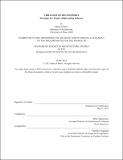Urbanism of disassembly : strategies for Alang's shipbreaking industry
Author(s)
Barve, Aditya S. (Aditya Shankar)
DownloadFull printable version (61.74Mb)
Alternative title
Strategies for Alang's shipbreaking industry
Other Contributors
Massachusetts Institute of Technology. Department of Architecture.
Advisor
Miho Mazereeuw.
Terms of use
Metadata
Show full item recordAbstract
Waste is an integral part of our contemporary civilization based on consumption and material culture. From an empty soda can to the spent nuclear fuel rod, we define waste as the matter without immediate use: rotten, broken, unwanted. The notion of waste is also spatial-waste is simply matter in the wrong place and consequently of no value. One defining feature of globalization is the flow of waste to the places that extract value out of this otherwise worthless matter. Situated on the western shore of the Gulf of Cambay in India, Alang is one such place. Alang owes its existence to the rise of modern maritime industry. Here obsolete end of life ships are broken, by manual labor, to transform them into a reusable commodity- steel. With an average lifespan of 25 to 30 years, most of these ships, often full of hazardous waste at the end of their working life, end up on the beach of Alang to be dismantled for their steel. Taking advantage of its unique geographical conditions, cheap migrant labor, and lax environmental regulations, Alang recycles half of the world's scrapped ships. It is the epicenter of a scavenger economy that turns obsolete vessels into reusable commodities for a rapidly developing economy. With the example of Alang, this thesis asserts that, due to their intricate connectivity to the global networks, places of resource extraction acquire an extra-territorial urban character. Only by acknowledging the urban nature of such places, can we start to design for these flows of waste, migration and resources. This thesis aims to explore the potential for urbanism to intervene into an industry like Alang to develop a regional strategy of urban metamorphosis.
Description
Thesis (S.M. in Architecture Studies)--Massachusetts Institute of Technology, Dept. of Architecture, 2013. Cataloged from PDF version of thesis. Includes bibliographical references (p. 137-143).
Date issued
2013Department
Massachusetts Institute of Technology. Department of ArchitecturePublisher
Massachusetts Institute of Technology
Keywords
Architecture.